We here present an annual caleidoscope of ancient Roman, Latin epigraphic sources. The twelve documents are tombstones of enslaved or formerly enslaved children. Apart from providing a snapshot on the (end of the) life of an enslaved child, these tombstones also give an indication of the analytical and interpretative complexities that this seemingly simply source material brings to the table.
We hope that readers will find this material and the questions raised by it thought-provoking, and that this collection of evidence may be useful for both school and private study. Each document is accompanied by a (very) brief commentary that highlights some of the most crucial aspects for the exploration of this material in the study of Roman slavery. The brief bibliographic pointers are enriched by the longer list given under Reading materials.
Document 1: The case of Prima (CIL XI, 2071)
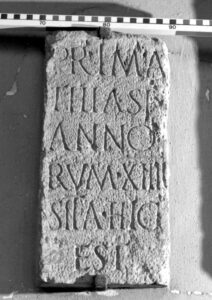
PRIMA / THIASI / ANNO/RVM XIIII / SITA HIC / EST
English translation: Prima (slave) of Thiasus, aged 14 (at death). Here she lies.
Brief commentary: This simple tomb-marker commemorates a 14-year old called Prima. The monument comes from Perusia (modern-day Perugia) in Etruria, and is dated to the first century of imperial rule. Although quite rough and basic, it is more than what the majority of individuals in antiquity could have hoped for in terms of funerary commemoration.
Prima is identified on the stone as ‘of Thiasus’. A standard way of rendering the possessive is to understand it as an indicator of slavery, i.e. ‘Prima (slave) of Thiasus’. Prima’s age does not rule out that she may have been the wife of Thiasus, i.e. instead of being enslaved to him (so: ‘Prima (wife) of Thiasus’), demonstrating how even a simple epitaph can create interpretative challenges. The view taken here is that of the documentation of enslavement, because of the fact that of the five tombstones from the region (Etruria) which (likely) document enslaved minors only one presents a clear linguistic identification as ‘ser(vus)’, i.e. the slavery-link appears regularly expressed differently.
Further reading: A. Carandini and S. Settis, Schiavi e padroni nell’Etruria romana: La villa di Settefinestre dallo scavo alla mostra (Bari, 1979)
Document 2: The case of Donicus (AE 2002, 1125)

D(is) M(anibus) / VALENS ET / MELANIA / CAESERNI AVITI / SERVI SIBI ET
VALENTINAE AN(norum) XX / ET DONICO AN(norum) II / FILIIS KARISSIMI[s]
English translation: To the divine manes. Valens and Melania, slaves of Avitus Caesernius, to themselves and to Valentina, aged 20, and to Donicus, aged 2, dearest children.
Brief commentary: This richly decorated funerary stele comes from Andautonia in the Roman province of Pannonia; it is dated to the second century of Roman imperial rule. The epitaph and relief depict a family consisting of four members: the father Valens, the mother Melania, the 20-year old daughter Valentina, and the 2-year old son Donicus.
The epitaph documents the family’s enslavement to Avitus Caesernius. The imagery documents simultaneously the family’s embeddedness in local custom and tradition: both women are clothed in the traditional clothing for the region, while Valens wears a tunic and coat, and holds a whip, an equally standard outfit for men at this time and in this place. Apart from demonstrating strong family ties, the tombstone thus also illustrates the cultural ties that enslaved persons may have with the region in which they live, raising broader questions about the nature of Roman slavery and its impact on the social status of the enslaved.
Further reading: B. Migotti, M. Sasel Kos, I. Radman-Livaja, Roman Funerary Monuments of South-Western Pannonia (Oxford, 2018), 88 (no. 6)
Document 3: The case of Fortunata (AE 2006, 424)

D(is) M(anibus) / PICENTINAE / CON(servae) RARISSIME / ITEM FORTVNATAE / FILIAE QVAE / VIXIT ANNIS XI / MENS(ibus) VIII, DIEB(us) XIII / PARTHICVS
English translation: To the divine manes of Picentina, most precious fellow-slave; also of Fortunata, the daughter, who lived 11 years, 8 months, 13 days. Parthicus.
Brief commentary: This badly weathered funerary altar comes from Matilica (modern-day Matelica) in the Italian region of Umbria; it is dated to the second century of Roman imperial rule. The epitaph commemorates two individuals – mother and daughter: Picentina and Fortunata. The commemoration was undertaken by a man called Parthicus. Parthicus identifies Picentina as his fellow-slave (conserva), thus giving away his own subjection to slavery. While the legal status of the 11-year old Fortunata is not given, it is highly likely that she, too, was enslaved, given the (current) legal status of her mother.
Thus, despite several uncertainties in the interpretation of this short text, the most straightforward reading of this epitaph is that of presenting a nuclear family: the father, Parthicus, who survives his wife and daughter, commemorates these on this altar: the stone documents a nuclear family in slavery, with the ability to commemorate the deceased family members in death.
Document 4: The case of Eutyches (CIL VI, 22972)
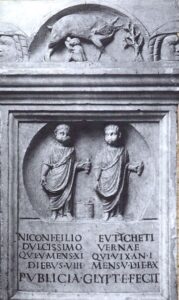
D(is) M(anibus) // NICONI FILIO / DVLCISSIMO / QVI V(ixit) MENS(ibus) XI / DIEBVS VIII // EVTYCHETI / VERNAE / QVI VIX(it) AN(no) I / MENS(ibus) V DIEB(us) X // PVBLICIA GLYPTE FECIT
English translation: To the divine manes. To Nicon, the sweetest son, who lived 11 months, 8 days. To Eutychus, the verna, who lived 1 year, 5 months, 10 days. Publicia Glytpe made (this).
Brief commentary: This stunning funerary altar from Rome of the early imperial period commemorates two young boys: Nicon, not yet one year old when he died, and Eutyches, just under one-and-a-half years old when he died. The commemoration was undertaken by a woman called Publicia Glypte. The text suggests that Nicon was her son (‘filio‘). Eutyches is referred to as verna – home-born slave. In juxtapositioning the use of ‘verna‘ (regarding Eutyches) with the use of ‘son’ (for Nicon), the term ‘verna‘ is highly suggestive of Eutychus’ enslavement. Perhaps he was the play-mate of Nicon?
None of these interpretations are secure: at base, the precise legal and civic status of each of the three individuals is unclear. Another intriguing aspect is the fact that both boys are represented in the toga, with book-scrolls in their hands and on wee pedestals. The representation shows the futures lost, given that at their young ages, neither boy would have been able to enjoy a liberal education yet.
If one understands the legal statuses of the two boys as that of a free boy and an enslaved boy respectively, then the visual representation of Eutyches demonstrates that the hope for a future, and for a future contribution to civil society, was expressed (and hence entertained) not just for free, but also for enslaved folk.
Further reading: J. Mander, Portraits of Children on Roman Funerary Monuments (Cambridge, 2013), 175-176 (no. 73).
Document 5: The case of Silvana (AE 1978, 201)
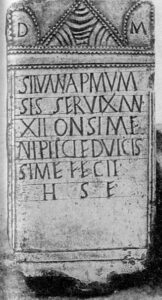
D(is) M(anibus) / SILVANA P(ubli) MVM(mi) / SIS(ennae) SER(va) VIX(it) AN(nis) / XII ONSIME NIPTICLE DVLCIS/SIM(a)E FECIT / H(ic) S(ita) E(st)
English translation: To the divine manes. Silvana, the slave of Publius Mummius Sisenna; she lived 12 years. Onsime made (this) for the sweetest grand-daughter. Here she lies.
Brief commentary: This tombstone for the 12-year old Silvana is a beautifully carved stele. While the artistic programme of the stele keeps to lines and dots, it is nevertheless notable. The tombstone comes from Brundisium in southern Italy (modern-day Brindisi), and is dated to the second century of Roman imperial rule.
The most striking element of this epitaph is that the deceased Silvana is commemorated by her grandmother, a woman who calls herself Onsime. It’s possible that Onsime’s name was actually Onesima, and that either the woman or the stone cutter made a mistake writing it; this may be indicated by the fact that the reference to Silvana as grand-daughter is not written in the standard form (i.e. ‘nipticle‘, in place of ‘nepticulae‘).
Whether or not there are spelling mistakes or merely spellings that do not follow what modern scholars perceive to be the grammatical standard, Silvana evidently knew her grand-mother, despite being in slavery. In short, this epitaph is evidence for the maintenance of familial ties that go beyond the parent-child-generational link.
Further reading: A. Donati, ‘Iscrizioni latine da Sandonaci (Brindisi)’, Epigraphica 32 (1970), 158-160 (with Fig. 1)
Document 6: The case of Faustus (CIL IX, 6732)

FAVSTVS A(nnorum) XV ET AVCTVS / A(nnorum) XXII SOCELLI C(ai) SER(vi) / HIC SITI SVNT MONVME(ntum) PARENTES FECERE.
English translation: Faustus, 15 years of age (at death), and Auctus, 22 years of age (at death), slaves of Gaius Socellius; here they lie. The parents made the monument.
Brief commentary: This tomb plaque commemorates two brothers in Italian Terventum (modern-day Trivento): Faustus and Auctus. Faustus was 15 years old when he died; his brother 22 years old. The brothers’ commemorators are their parents. The latter remain unnamed on the stone, which is not unusual.
While the text does not provide any further details, the fact that the nuclear family unit appears intact, and that the parents were in a position to commemorate their deceased children, is notable. Obviously, it is not possible to know from this epitaph if the family also included other siblings, either alive or by now already deceased. It is therefore not possible to use this kind of evidence to reconstruct the fullness of family relations in slavery.
Further reading: G. Fratianni, Terventum. Carta Archeologica della media valle del Trigno (Galatina, 2010), 154-155
Document 7: The case of Laurus (CIL VI, 21172)
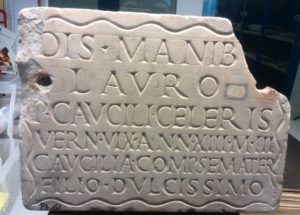
DIS MANIB(us) / LAVRO / P(ubli) CAVCILI CELERIS / VERN(ae) VIX(it) ANN(is) XIII M(ensibus) III / CAVCILIA COMPSE / MATER FILIO DVLCISSIMO
English translation: To the divine manes. To Laurus, the home-born slave of Publius Caucilius Celerus. He lived for 13 years and 3 months. Caucilia Compse, the mother, to the sweetest son.
Brief commentary: This funerary plaque commemorates the 13-year-old Laurus. The commemorator is Laurus’ mother, Caucilia Compse. The text is beautifully inscribed on a very nice marble plaque. The plaque comes from Rome, and was probably displayed in a sizeable columbarium, among many other tombs and epitaphs. It is dated to the first half of the first century of Roman imperial rule.
The deceased is labelled as ‘verna’, which we take in the context here presented to identify him as a ‘home-born slave’, in this case of a man called Publius Caucilius Celerus. The term can also be used outside a slavery context, which may encourage a reading of the relationships among the mentioned individuals entirely outside the world of slavery. But given that many enslaved children were commemorated by their mothers (or other family members), the fact that his mother set up the stone does not question the boy’s legal status as that of a slave.
There is an additional matter that raises interesting questions: the mother has the same nomen as the mentioned owner of Felix – Caucilia and Caucilius respectively. This would imply that she was herself once owned by Caucilius, but that she had meanwhile gained freedom, even if she does not specify her current status and relationship to Publius Caucilius Celerus. If this interpretation is correct, we must assume that Caucilia Compse gave birth to Laurus when she was still enslaved herself. This would also mean that the tombstone documents the maintenance of family ties after the mother’s liberation from slavery. Of course, it is also possible that Publius Caucilius Celerus is the father of Laurus: again, this does not stand in the way of seeing Laurus as his slave, born to one of the women over whom he exercised the powers of ownership, i.e. Compse.
The final suggestion raises the thorny issue of sexual relations in slavery: at one extreme, there may have been an emotional relationship between the master and his slave – here Compse; at the other extreme, the enslaved female may have been subjected to sexual abuse, and the child the result of rape. There is no way from the evidence at hand to gain clarity on the matter.
Further reading: Hermann-Otto, E., Ex ancilla natus. Untersuchungen zu den ‘hausgeborenen’ Sklaven und Sklavinnen im Westen des römischen Kaiserreiches (Stuttgart, 1994), 7-21
Document 8: The case of Felix (ILJug-3, 2615)

D(is) M(anibus) / FELICI CAES(aris) / N(ostri) SER(vo) AN(norum) VIII / ANTIOCHVS / FRATRI PIIS/SIMO
English translation: To the divine manes. To Felix, the slave of our Caesar. Aged 8 (at death). Antiochus (made this) for the most pious brother.
Brief commentary: This relatively simply tombstone presents an inscribed surface that remembers the deceased 8-year-old Felix. Felix is remembered as a slave of the emperor, i.e. he belonged to the imperial household. The tombstone is dated to the second or third century of imperial rule. It comes from Solin in modern-day Croatia, i.e. from the ancient province of Dalmatia, near the Adriatic coast.
Although fairly simple, the tombstone provides evidence for the involvement of the imperial power in slavery. We don’t know if Felix was born into slavery; we might speculate that he was not, because he is not labelled as a so-called ‘verna’ (as for instance Laurus: Document 7). That said, he is commemorated by his brother, Antiochus, who may not have bothered to give this kind of label on the tombstone.
Again, we are faced with more questions than answers: what was Felix’ role in the imperial household? Did he also know, and was close to, his parents? Was his brother, Antiochus, also enslaved? And so forth.
Further reading: Brøndsted, J., in Recherches à Salone 1 (Copenhagen, 1928) 161-162, no. 19; fig. 171
Document 9: The case of Peregrinus (CIL XIII, 6109)
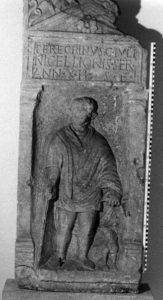
PEREGRINVS C(ai) IVLI / NIGELLIONIS SER(vus) / ANN(orum) X H(ic) S(itus) E(st)
English translation: To Peregrinus, slave of Gaius Iulius Nigellio, 10 years (old at death). Here he lies.
Brief commentary: This beautifully decorated tombstone comes from the Roman province of Germania Superior. The stone has been found in modern-day Speyer, in the western German region known as the Pfalz, located near the river Rhein. As with most other tombstones here featured, the epitaph is dated to the Roman imperial period. It is made from a limestone block.
The tombstone was set up to commemorate the deceased Peregrinus. The boy died at the age of ten. He was enslaved to one Gaius Iulius Nigellio. It is not known who commissioned the stone: there is no information on the mourners: this, too, is not unusual, for both enslaved and free folk.
As is self-evident, the epitaph is beautifully decorated. The deceased boy is represented with a small number of attributes, including a (pet) dog. The relief is deeply cut into the stone to give it maximum visual force. The top of the stone is moreover decorated with floral motives, just above the actual inscribed epitaph. In sum, the tombstone did not come cheap.
But who set it up? And where did Peregrinus come from? Was he born into slavery, or was he rather sold into slavery? Was his owner a Roman citizen? This can perhaps be deduced from his three names – the so-called tria nomina, even if this is not a safe indicator. There are, clearly, more questions raised than answers given by this seemingly simple ancient relic.
Further reading: Schumacher, L., Sklaverei in der Antike: Alltag und Schicksal der Unfreien (Munich, 2001), 77
Document 10: The case of Antonia (CIL III, 11497)
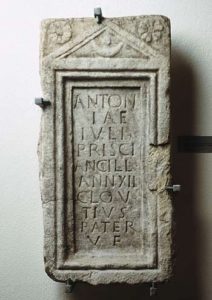
ANTON/IAE / IVLI / PRISCI / ANCILL(ae) / ANN(orum) XII / CLOV/TIVS / PATER / V(ivus) F(ecit)
English translation: To Antonia, female slave of Iulius Priscus, 12 years (old at death). Cloutius, (her) father, made this (tombstone) while alive.
Brief commentary: This tombstone, a marble stele, comes from the Roman province of Noricum, and more precisely from the area of modern-day Weißenstein in southern Austria. It is dated to the Roman imperial period, and was probably erected in the first century of imperial rule.
The tombstone commemorates a young girl, who died aged twelve. The girl, whose name is given as Antonia, is remembered by her father, a man called Cloutius, as the female slave of a man called Iulius Priscus.
The epitaph is nicely cut. The tombstone sports some neat decorations – both a rectangular frame around the text as well as floral decorations at the top. It is intriguing to read that the stone was set up by the girl’s father who describes his daughter as the slave of another man.
Naturally, the question arises as to whether Antonia’s father was also enslaved, and if so, whether he was enslaved to the same man as his daughter; but we cannot tell from the evidence at hand – which is at the same time all we probably ever will know about these individuals. Whether or not the father was enslaved too, it is clear that the daughter’s enslavement was not an obstacle to family commemoration – as is also evidenced in several other cases showcased in this epigraphic caleidoscope.
Further reading: Piccottini, G., Die Römersteinsammlung des Landesmuseums für Kärnten (Klagenfurt, 1996), 105-106, no. 52
Document 11: The case of Murricia Primigenia (CIL XI, 489)
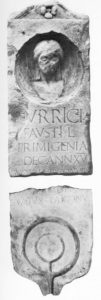
[M]VRRICIA / FAVSTI L(iberta) / PRIMIGENIA / DEC(essit) ANN(os) XV / QVO DIE VIRGO NVBSIT / EODEM DIE POST ANNVM / SEPVLTA EST / FAVSTVS PATRONVS
English translation: Murricia Primigenia, the freedwoman of Faustus, died aged 15; on the same day on which as a maiden she was married, she was buried one year later. Faustus her patron (made this)
Brief commentary: This tombstone comes from ancient Ariminum (modern-day Rimini on the Italian Adriatic coast) and is from the first century of imperial rule. It commemorates a teenage girl called Murricia Primigenia, who died at the age of fifteen, at which point she had been manumitted from slavery: she is labelled as a freedwoman, a ‘liberta’ on the tombstone, with the standard abbreviation ‘L’.
The tombstone documents that early manumission was possible, but ii is on the other hand also evidence for the enslavement of children. We cannot know at what age the commemorated teenager was enslaved (perhaps from birth?), nor at what age she was manumitted. The tombstone was set up by her so-called patron – a man called Faustus – who was her former owner.
Besides Murricia Primigenia’s earlier enslavement, and her subsequent manumission from slavery, the epitaph also illustrates the occurrence of marriage at ages that are deemed early in many parts of the world today: the stone records that she was buried one year after her wedding, implying that she was married at the age of 14.
Questions that press forward, but that cannot be answered from the evidence at hand, are many:
Was Murricia Primigenia married to her patron, i.e. her former owner? Was she freed for the purpose of marrying him? Did she die in childbirth? And so forth.
Further reading: Barresi, C., Le iscrizioni funerarie di Ariminum (2018), no. 92
Document 12: The case of Gnaeus Domitius (AE 1957, 217)

D(is) M(anibus) / CN(aei) DOMITI / MODESTI F(ilii) / VIX(it) ANN(um) I M(enses) XI / CN(aeus) DOMITIVS / PARIS DELICATO / ET LIB(erto) SVO FEC(it)
English translation: To the divine manes. To Gnaeus Domitius Modestus, the son. He lived for 1 year, 11 months. Gnaeus Domitius Paris made this for his ‘sweet-heart’ (‘delicatus’) and freedman.
Brief commentary: This tombstone comes from ancient Heba (modern-day Magliano in Toscana, roughly 100 km north-west of Rome); it is dated to the first century of imperial rule. The tombstone commemorates a young boy, who died before turning two, aged one year and eleven months. The boy, whose name is given as Gnaeus Domitius Modestus is commemorated by a man called Gnaeus Domitius Paris – who is both his former owner and father – also explaining the overlap in much of their names, i.e. the praenomen (Gnaeus) and the nomen (Domitius).
The epitaph illustrates the complexities of relationships that can develop in slavery. Given that the boy was freed by Gnaeus Domitius Paris at a very early age, he was likely born into slavery by a woman enslaved to Gnaeus Domitius Paris. There are several questions that press forward from this short text:
Was the boy’s mother also freed? Why does she not participate in the commemoration? Did the boy’s former owner exclude her from this because of her servile status? Or was she dead by the time the boy died? What kind of relationship did Gnaeus Domitius Paris have with the boy’s mother? Was it an emotional relationship that both partners enjoyed, or was the pregnancy that led to the boy’s birth the result of sexual abuse, i.e. rape? Both extremes are possible.
Further reading: Eck, W. and Pack, E. ‘Das römische Heba. Materialien aus der Vorarbeit zu CIL XI Suppl. alterum’, Chiron 11 (1981), 139-168, at 153